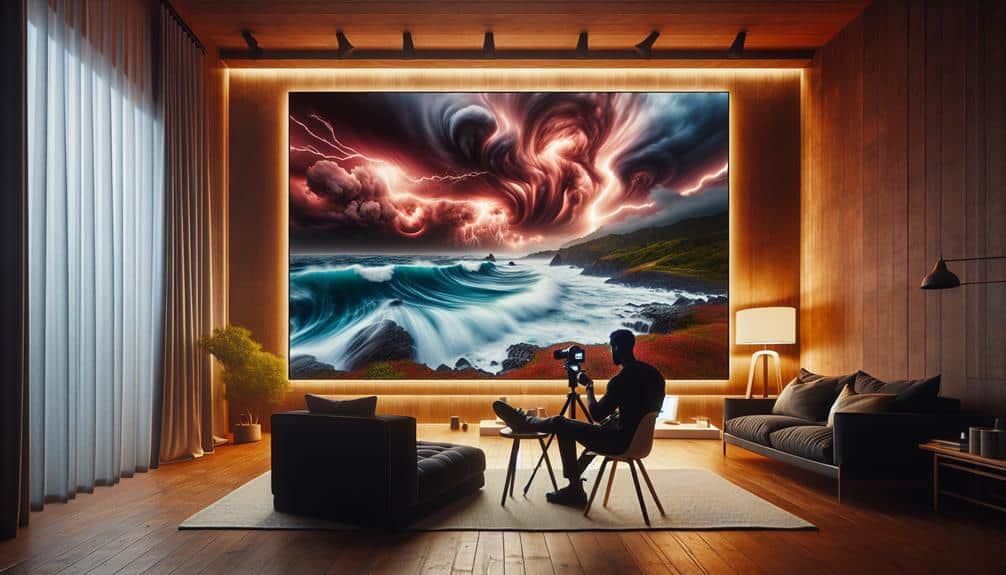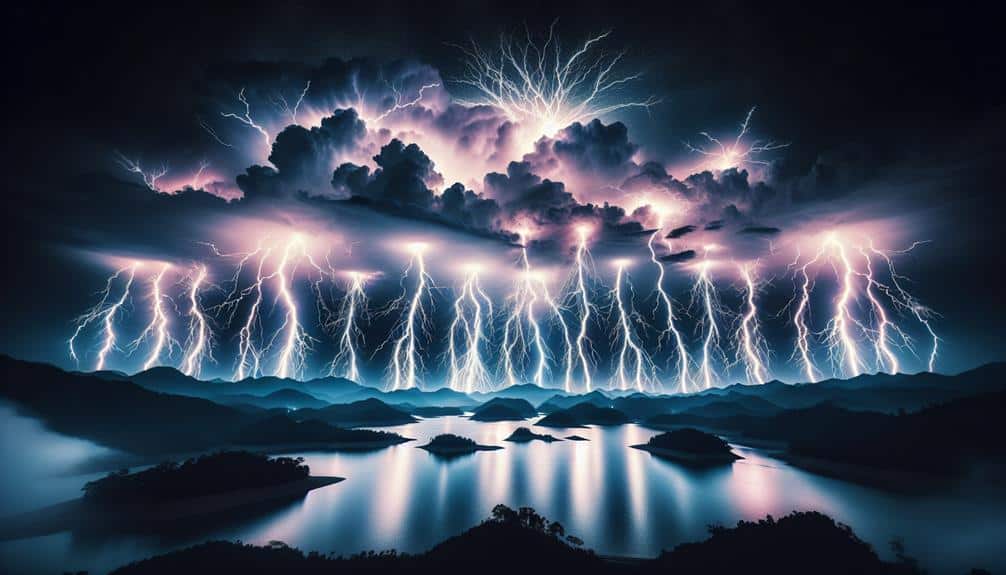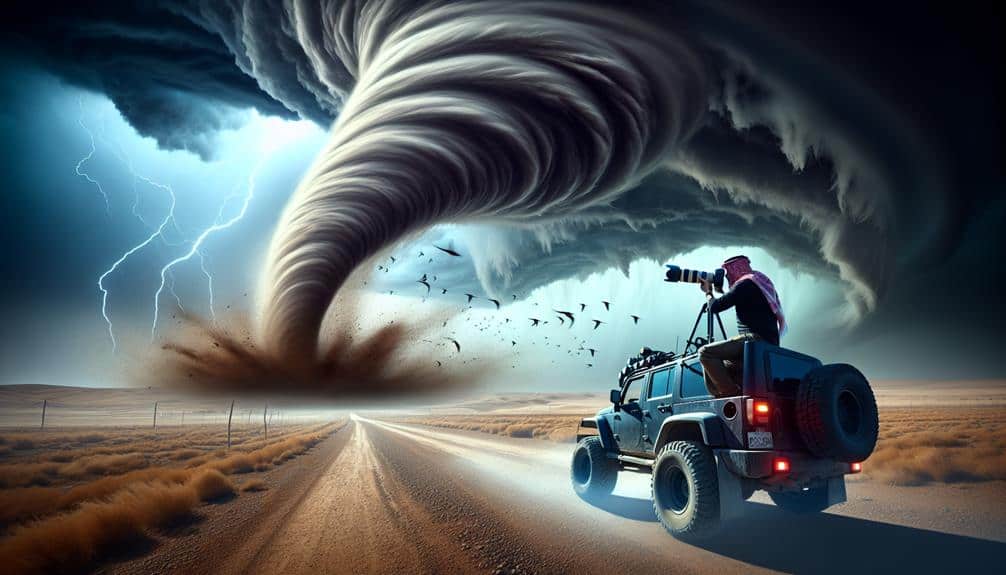We can capture stunning long exposure shots in extreme weather by using weatherproof gear, including a sealed camera body, lens, and a sturdy tripod. Let's choose dynamic locations with moving clouds or waves and check weather forecasts for safety. Adjusting shutter speed, aperture, and ISO is key, while remote shutter release and Bulb Mode help maintain control. Stabilize shots by securing tripod legs and employing a wide stance. Post-processing in software like Lightroom or Photoshop further enhances our shots by fine-tuning colors, noise, and depth. Discover our artistic vision and technical prowess in action as we master these conditions.
Key Points
- Use weather-sealed camera bodies and lenses to protect against harsh elements.
- Stabilize shots with a sturdy, weather-resistant tripod and a remote shutter release.
- Adjust camera settings: low ISO, appropriate aperture, and Bulb Mode for extended exposures.
- Wear insulated and waterproof clothing to stay safe and comfortable during extreme conditions.
Essential Gear for Extreme Conditions
When tackling long exposure shots in extreme weather, we need specialized gear to safeguard both safety and quality results. First and foremost, weatherproof equipment is non-negotiable. A weather-sealed camera body and lens protect our gear from rain, snow, and dust.
Investing in a sturdy tripod with weather-resistant features ensures stability in windy conditions. It's also essential to use lens hoods and UV filters to shield our lenses from the elements.
In addition to our camera gear, we can't overlook the importance of cold weather clothing. Layering is key: thermal base layers, insulated jackets, and waterproof outer shells keep us warm and dry. Don't forget gloves that allow dexterity for camera adjustments, and thermal socks to maintain circulation.
Our artistic vision shouldn't be compromised by discomfort or equipment failure. By prioritizing weatherproof equipment and appropriate cold weather clothing, we can focus entirely on our creative process. We gain the freedom to explore the visual possibilities that long exposure photography offers, even in the harshest conditions.
This preparation allows us to capture stunning images without the distraction of worrying about our safety or the integrity of our gear.
Selecting the Perfect Location
Identifying the ideal location for long exposure shots in extreme weather requires a balance of safety considerations and artistic potential. We need to prioritize weather considerations while scouting spots. Checking weather forecasts and understanding weather patterns is essential. Knowing if a storm is approaching or if temperatures will drop significantly allows us to be prepared and responsive.
Scouting spots ahead of time can save us from potential hazards and open up creative possibilities. Look for locations with dynamic elements like moving clouds, crashing waves, or bustling city life that can enhance the drama in our long exposures. Pay attention to environmental factors such as tide schedules, wind speeds, and the stability of the ground.
Safety precautions are non-negotiable. We must make sure we're not too close to dangerous elements like cliff edges, fast-moving water, or unstable terrain. Proper gear like non-slip shoes, weatherproof clothing, and first aid kits are vital. Always let someone know our plans and expected return time, especially when venturing into remote areas.
Camera Settings for Long Exposures
Mastering camera settings for long exposures in extreme weather demands both technical precision and a keen artistic eye. To capture the astonishing beauty of nature in challenging conditions, we need to understand how to manipulate our cameras efficiently.
Let's break it down:
- Shutter Speed: For long exposures, set your shutter speed to a few seconds up to several minutes. This helps create dreamy effects, such as smooth water or dynamic cloud movement. When shooting at night, especially for astrophotography, use a longer duration to capture star trails.
- Aperture and ISO: Adjust your aperture to a smaller f-stop (e.g., f/8 to f/16) to maintain sharpness and depth of field. Balancing ISO is essential; keep it low (100-400) to reduce noise, especially important in low-light conditions. This is crucial for clean images during light painting or capturing creative effects.
- Bulb Mode and Remote Shutter Release: Utilize Bulb Mode for exposures longer than 30 seconds, giving us complete control. Pair this with a remote shutter release to prevent camera shake, ensuring crisp results even in turbulent weather.
Techniques for Stabilizing Shots
To guarantee our long exposures remain sharp in extreme weather, we must use effective techniques for stabilizing shots. First and foremost, using a sturdy tripod is essential. We should opt for one with a hook to hang a weight, adding stability against wind gusts. Planting the tripod legs firmly into the ground and extending the legs minimally will reduce vibrations.
Additionally, using a remote shutter release or the camera's timer function prevents camera shake during exposure.
For those of us who prefer handheld options, maintaining stability is more challenging but not impossible. We can brace our bodies against solid structures like trees or walls to minimize movement. Tucking our elbows close to our body and using the viewfinder instead of the LCD screen can provide extra stability.
It's also helpful to use a wide stance and steady our breathing before pressing the shutter.
In extreme weather, every detail matters. Employing these tripod techniques and handheld options will secure our long exposure shots capture the beauty and drama of the scene without unwanted blur. With practice and precision, we can achieve stunning results regardless of the elements.
Post-Processing Tips and Tricks

Let's immerse ourselves in the art and science of post-processing to enhance our long exposure shots captured in extreme weather. Post-processing is where we can truly bring out the magic in our images, emphasizing the surreal and dramatic elements that extreme weather contributes.
Here are three essential steps to elevate our shots:
- Color Adjustment: Adjusting the colors can make a world of difference. Use software like Adobe Lightroom or Photoshop to fine-tune the white balance, saturation, and hues. This ensures that our images reflect the true atmosphere and mood we experienced during the shoot.
- Noise Reduction: Long exposures in low light can introduce a lot of noise. We can use tools like Lightroom's noise reduction sliders or specialized plugins like Topaz DeNoise AI. Carefully apply noise reduction to maintain sharpness while removing distracting grain.
- Dodging and Burning: This technique helps highlight contrasts and adds depth to our images. By selectively lightening and darkening areas, we can guide the viewer's eye and emphasize the dramatic elements of the scene.
Frequently Asked Questions
How Can I Protect My Camera From Extreme Weather Conditions?
We can protect our cameras by using waterproof camera cases and camera rain covers. Additionally, silicone lens hoods prevent moisture buildup, and lens heaters combat condensation, ensuring we capture our artistic vision without weather constraints.
What Are the Best Clothing Choices for Photographing in Harsh Weather?
For freezing expeditions, we emphasize layering suggestions and gear essentials. Choose waterproof footwear options and thermal socks. Accessory recommendations: insulated gloves and windproof hats. Proper attire guarantees our comfort and creativity thrive, even in harsh weather's harshest moments.
How Do I Keep My Camera Lens From Fogging up in Cold Conditions?
To maintain our camera lens from fogging up in cold conditions, we should prioritize lens maintenance and use anti-fog solutions. Regularly cleaning our lenses and applying anti-fog sprays will guarantee clear shots, maintaining our artistic vision.
What Safety Precautions Should I Take When Shooting in Extreme Weather?
Did you know extreme weather causes 500 photography-related injuries annually? We should carry an emergency kit, check a weather app, have a communication plan, and pack backup gear. Let's stay safe while capturing our artistic visions.
How Can I Keep My Batteries From Draining Quickly in Cold Temperatures?
To address battery preservation in cold weather, let's insulate our equipment. Use thermal covers and keep spare batteries warm in pockets. Protect gear from snow and rain to guarantee peak performance and longevity during shoots.


